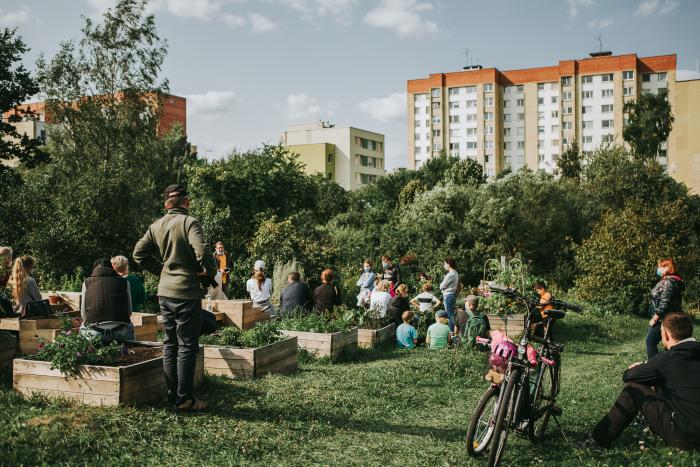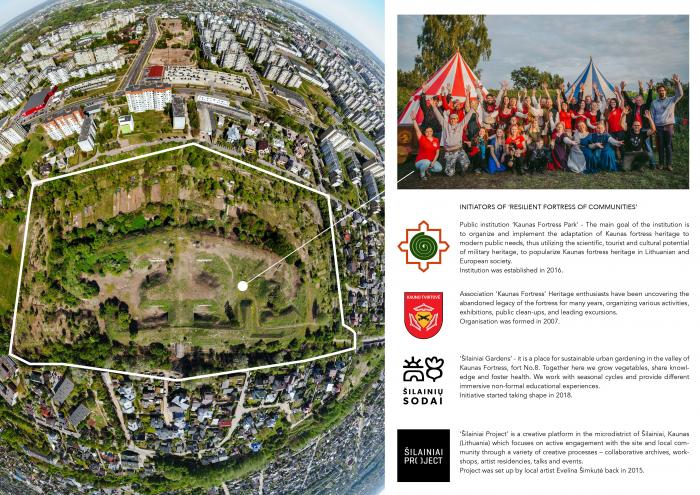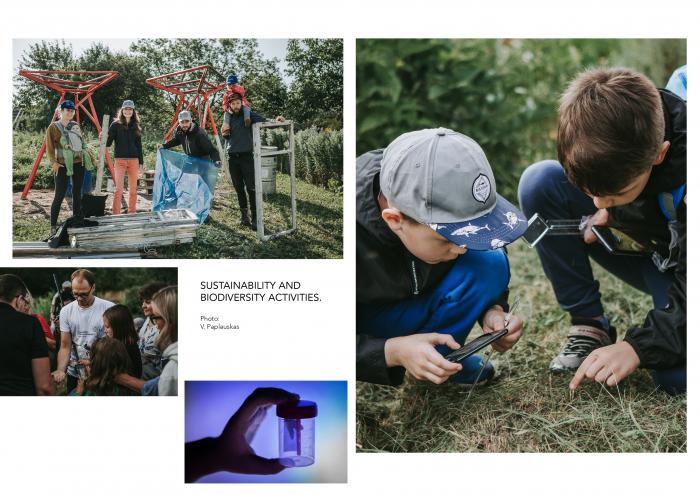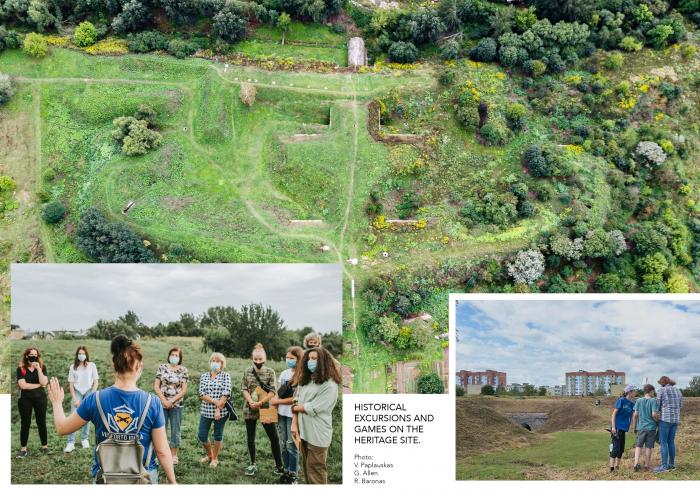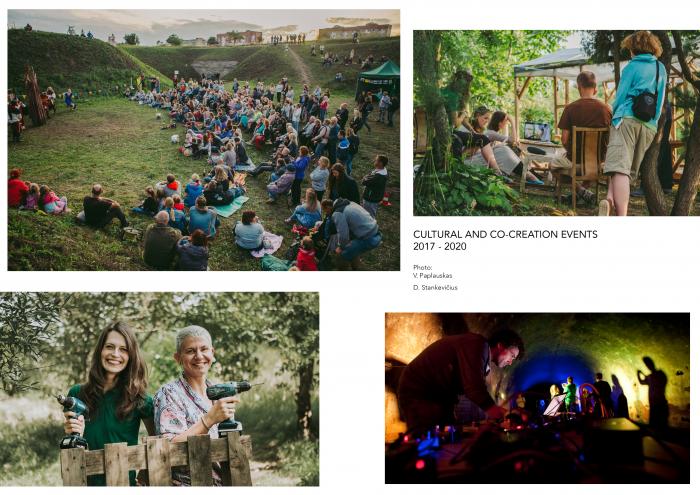I. SUMMARY INFORMATION
Project
269305
Status
Submitted
Award category
Regenerated urban and rural spaces
You want to submit
NEW EUROPEAN BAUHAUS AWARDS : existing completed examples
Project title
Resilient Fortress of Communities
Full project title
Reframing military fortress as a community hub
Description
Heritage management institution, local arts initiative, urban gardening community and passionate heritage volunteers working together for 5 years to change the abandoned First World War heritage site to a resilient community hub in harmony with nature and history.
Largely based on voluntary effort and with limited funds, this has been a long, open co-creation process which has led to a unique place for arts and culture, biodiversity and community urban gardening with sustainability at heart.
Where was your project implemented in the EU?
Lithuania
Kaunas
Pryšmančių g. 2c
54° 55' 10.92'' N
Longitude 23° 53' 23.964'' E
Kaunas
LT48297
When was your project implemented?
Has your project benefited from EU programmes or funds?
No
Which programme(s) or fund(s)? Provide the name of the programme(s)/fund(s), the strand/action line as relevant and the year.
II. DESCRIPTION OF THE PROJECT
Please provide a summary of your project
‘Resilient Fortress of Communities’ is a 5 year regeneration effort within the city of Kaunas to develop Fortress No.8 based on the principles of sustainability seeking synergy among community, nature and history. Fortress No.8 is part of the city wide, circular network of fortifications where artificial reliefs and underground structures are dominant. This regeneration is focused around the Fortress No.8 which was built in 1889-1890. Already during construction this Fortress was an experimental project and now it holds deep historical insights and cultural memory. More than 10 years ago enthusiasts embarked on the journey to preserve historical and cultural heritage that fortresses represent and formed an Association ‘Kaunas Fortress’. Since 2016 these efforts evolved into the pursuit to open Fortress No.8 for co-creation. The collaboration between volunteers, public institution ‘Kaunas Fortress Park’ and the creative platform ‘Šilainiai Project’ gave rise to many experimental events, exhibitions and experiences, in other words, evolving cultural programming. Fortress No.8 acts as a ground for conversation, where diverse input from various actors and social groups are welcome. In order to welcome the diversity of the objectives we focused a lot on security and accessibility of the site, storytelling and historical memory, as well as working with the nature that in a way took over the management of the fort for some time. Throughout the history fort acted as a defence system, home for displaced people, food storage, historical treasure, food provider and now it is slowly becoming a community hub in one of the most densely populated neighbourhoods in Kaunas, that lacks quality, accessible public spaces and cultural activities. By reframing the fort as a community hub we brought culture and science closer to people, provided time and space for the crossing of diverse cultures, thoughts and experiences contributing to overall sustainability of the city.
Please give information about the key objectives of your project in terms of sustainability and how these have been met
Sustainability in this community hub permeates all its aspects. Through the focus on a specific place we expanded the functionality of the site contributing to effective land use within the city territory. We provide a space for historic storytelling, exploring and relating to place identity, intergenerational communication, and human-nature connectedness. We contribute to climate change mitigation and adaptation efforts by bringing many functions closer to people, developing new life skills, exploring soil remediation methods that help sequester carbon and reduce pollution. Through this work we are setting an example of what sustainability can look like on a neighbourhood level.
In terms of environmental sustainability we worked to ensure a healthy, safe and thriving biosphere in the fort. During the last 5 years, the project site went through a number of pollution reduction activities. These involved managing the invasive and dangerous to humans plant species, collection and proper disposal of accumulated waste, and collaboration with scientists in order to lead informed development of the fort.
In terms of social sustainability we initiated and facilitated transdisciplinary collaborations. Our created space is oriented for maximum inclusivity in terms of age, gender, income, abilities and capabilities. Through continuous presence on site we are fostering feelings of belonging, community and encourage communication. Through diversity of cultural activities we provide space for creators, scientists and society to interact and work together.
In terms of economic sustainability we experimented with circularity and urban gardening to increase resilience beyond economic benefits. We embraced sharing economy principles where our participants through their time and skills contribute to developments on site. All our activities were oriented to maximum economic accessibility, which meant providing most of our activities for free for all, even with limited project funds.
Please give information about the key objectives of your project in terms of aesthetics and quality of experience beyond functionality and how these have been met
Here we would like to frame the fundamental objectives of our activities as three values that permeate our work: community, nature and history. Some of the most memorable experiences that we created combined nature and history of the place and provided space and time for experiencing these in a communal way.
We ensured space for multiple social groups, actors and activities to give rise to the collective aesthetics of the place. We believe this to be an important aspect of collaborative placemaking, where there are no “head architects or designers”. The aesthetics of the Fortress No.8 emerged from the values of sustainability and inclusivity, which meant that through a diverse set of activities and inclusive nature of the project an authentic to community aesthetic is created. It provides new seeds for discussions and raises questions that we actively debate again through our activities.
One of the main objectives since the beginning of all activities was to overcome historical aesthetics of abandonment and neglect of the fortress. This meant many practical actions mentioned in sustainability and inclusivity questions, as well as, focus on quality of experience in terms of navigating the continuum between clarity, cleanliness, order and creative expression, adaptability and flexibility. All of this contributes to one of the main objectives of our activities - to create conditions for the community and the place itself to dictate and create its aesthetics that fosters empathy, mind-body regeneration and creativity.
Through cultural programming we created many possibilities for exposure to diverse thoughts and cultures that challenge and broaden the identity and aesthetics of the place. Multiple events, exhibitions and experiences gave rise to the aesthetics we see today and the cultural programming, provided a kaleidoscope, through which everyone participating got the opportunity to see the place in a new light.
Please give information about the key objectives of your project in terms of inclusion and how these have been met
It is important to communicate the preexisting ground for the current development of the Fortress No.8. There were many grassroot initiatives, different social groups and institutions using the fortress separately, that led to emergent need for inclusion and collectivity. ‘Resilient Fortress of Communities’ does not end with the boundaries defined by the heritage location but overflow into the Šilainiai neighbourhood and Kaunas city itself.
Through diverse cultural programming we provided a space for a complex net of co-creators to empathize and work together.
We initiated and facilitated transdisciplinary collaborations to bring science and insights that help better understand the fort itself. Together with a community of co-creators we gather data of the location, create information sources that are accessible and understandable for all generations.
Our created space is oriented for maximum inclusivity in terms of age, gender, income, abilities and capabilities. We are improving the physical access to the location, creating gathering and educational spaces, evaluating soil and water conditions, offering free activities and continuously providing useful information via local communication channels to maintain the direct engagement.
Initiatives are shaped to nourish the ownership of creative process and encourage contributions. Through continuous presence on site we are fostering feelings of belonging, community and encourage communication. This process is changing citizens’ relation to the location and supports the habit of caretaking and accountability.
Through a cultural change the microdistrict inhabitants are invited to use the location as a recreational site, continue using it as a food source, and recognise and celebrate the authenticity of the neighbourhood. Activation of the community through arts and collective caretaking creates bridges between individuals, generations and various organisations involved.
Please give information on the results/impacts achieved by your project in relation to the category you apply for
For a long time Fortress No.8 was an abandoned military heritage site that was neglected and was increasingly becoming more dangerous and problematic to the community. Since it seemed to be ‘no one's land’ anarchy, pollution and even crime took over the identity of the place in the minds of neighbourhood inhabitants. The paradoxical identity of the place being associated with pain, trauma and war, since the late 80’s started to provide a space for the inhabitants of newly built Šilainiai district to grow their food and stay connected to the soil. People who ‘do not fit in’ with their activities in other public spaces found refuge in Fortress No.8. These examples can be seen as emblematic of the many challenges that territorial regeneration faces within large cities. Working within such a complex setting requires increased attention to the process of collaboration. The success of the project ‘Resilient Fortress of Communities’ rested on the mediation of the diverse objectives of communities, heritage professionals, local authorities, artists and scientists. At the moment we can claim that communal ownership of the fortress has been established and we overcame the identity and aesthetics of abandonment. Ensuring various levels of collaborative participation that spanned from visiting to working on site shaped a new well functioning public space open for everyone. Through the diversity of activities, events and ways of experiencing the place we have reduced all forms of segregation in terms of age, gender, income, abilities and capabilities. We provided a unique place and experiential opportunities in a densely populated soviet built neighbourhood that were not found anywhere else within it. Transdisciplinary or cross-sectorial collaboration has been established as an integral part of the project.
Please explain the way citizens benefiting from or affected by the project and civil society have been involved in the project and what has been the impact of this involvement on the project
The co-creation plays a key role in the evolution of the community hub. The initial activation of the fortress started by the citizen grassroots initiatives and is run and supported by various social groups co-creating the collective futures of the place. This process is happening on various levels through mediation and facilitation of conversations with citizens and institutions involved in the stewardship of the location. There are no superior designers or planners of the place thus it secures an authentic development process that is considerate to issues such as affordability, generation gap and inclusivity.
Through the inclusion and co-creation with citizens the remarkable location with a recreational potential was reinterpreted. This gave an opportunity for communities to view Fortress No.8 identity beyond its military heritage.
The project created opportunities for scientific research and activism. This way scientists and experts were able to share their findings about the location and how these results affect neighbours directly. The topics of biodiversity, soil and water quality became more apparent and the citizens started taking initiative to be considerate to the nature that hosts them. Cultural programming opened a discussion on cultural impact on microdistrict, contributing to healing of the historical trauma, socio-economic inequality and other pressing issues.
Through the continuous presence on site such as communal gardening and cyclic cultural programming, citizens gained access to culture, new knowledge and skills. Benefits for citizens include wider knowledge about food, plants, nature, human footprint, planning and problem solving skills, increased awareness and creativity. Presence of scientists and creators on site sparked citizen curiosity and wish to learn about their living environment that led to environmental awareness. Furthermore, Communal gardens continue to provide citizens with economical, environmental, social and health benefits
Please highlight the innovative character of the project
Using the WW1 heritage as a community place is not a common practice in Lithuania. This area is also environmentally sensitive and protected by Natura 2000 for maintaining biodiversity. Besides that it also requires a lot of intersectoral and cross-disciplinary work that we have engaged in.
Many heritage areas become highly focused on the aesthetic aspect and the inclusion becomes secondary. The conversation usually ends by authorities or higher in a hierarchy institution deciding the destiny of the place. Sometimes external experts are hired to do the analysis and renovate the locations rarely involving the citizens in the creation process.
Here we see a different approach brings the best long lasting results. In contrast to urbanization practices that apply certain models of aesthetics, here the community becomes the main data gatherer for the solutions to be made. This way gentrification of places when they are being made homogenous and adapted to a certain type of user is irrelevant and the already existing diversity in the area is being protected rather than later to be introduced from a new.
Bottom-up driven process might not be the quickest solution, however it builds different habits of the community and encourages a strong sense of ownership and accountability. This project is particularly innovative in its approach that does not suggest one vision for the place but rather creates a platform of co-creators to continuously share the conversation without a superior agenda, thus maintaining the context sensitivity.
An approach that is aiming to focus on the authenticity of already existing communities, their practices, interests and ways of communicating is building communities’ resilience and encouraging the ability to see the importance of collective decision making in the city planning. This approach also has a potential to grow the connection with city governance and re-build the trust between the government and communities.
Please explain how the project led to results or learnings which could be transferred to other interested parties
Learning 1: With continuous mediation and facilitation, heritage and nature protection areas can become community hubs and contribute to overcoming the mental nature-society divide that is deemed necessary to pursue sustainability. Our project challenged and transformed the view of how heritage and nature protection areas should be managed. The most important part enabling this transformation was mediation and facilitation. Before we established the conversation, the fort was a sort of ‘battle’ field of different interests trying to monopolise the territory. Long, careful, adaptive and continuous mediation and facilitation is key to delivering inclusive projects.
Learning 2: Flexible participatory co-creation establishes ownership and responsibility for the place. Co-creation has been a cornerstone element in this project. This requires active seeking for collaborators and ‘mixing’ them in various combinations to test what works and what the place needs. We had many specialists, artists, scientists, public servants and locals co-creating and interacting as equals where we created an environment where everyone's contributions are welcome. This intentional welcoming disperses the ownership of the project to all participating.
Learning 3: Decentralisation of decision making power, culture, arts, science, knowledge and social benefits in cities has to be a long and persistent pursuit that requires contextual sensitivity on a neighbourhood and even site level rather than the whole city as a uniform unit. The more we delved into the context of our site and got to know active people practicing their interests the more we noticed the unique potential this specific place holds. The existing situation itself informed all our activities and collaborations as it continuously provides us with a to do list. Once we have the new item on the list we embark on the journey to find who could work with it on site in this way bringing everything that the place needs straight to it.
Is an evaluation report or any relevant independent evaluation source available?
No
III. UPLOAD PICTURES
IV. VALIDATION
By ticking this box, you declare that all the information provided in this form is factually correct, that the proposed project has not been proposed for the Awards more than once under the same category and that it has not been subject to any type of investigation, which could lead to a financial correction because of irregularities or fraud.
Yes
